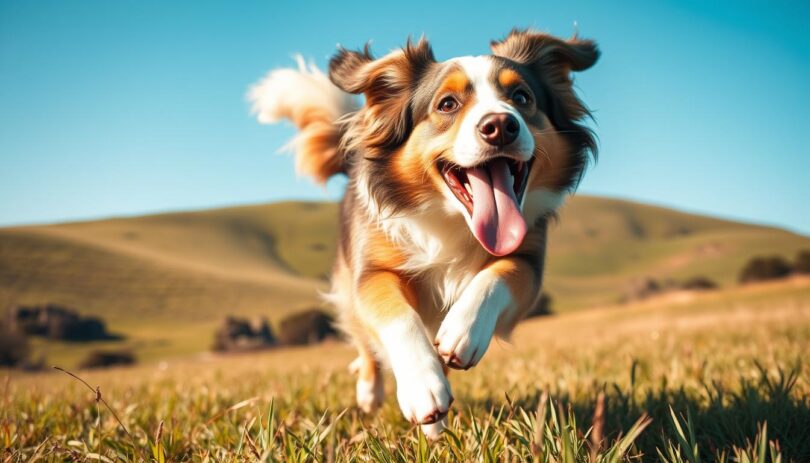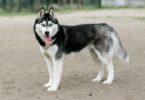What if the perfect family pet isn’t a purebred but a clever crossbreed bursting with energy and brains? This question drives many pet lovers to explore mixed-breed dogs that combine the best traits of multiple lineages. Among these, one standout continues to capture hearts nationwide.
Known for striking looks and sharp intelligence, these hybrids inherit qualities that make them ideal for active households. Their natural athleticism shines in agility tasks, while their loyalty fosters deep bonds with families. However, their high-energy nature demands engagement—think daily adventures and puzzle games.
This guide dives into their origins, care needs, and training strategies backed by expert insights. Whether you're curious about their herding instincts or hypoallergenic potential, you'll discover how to nurture a happy, healthy companion. Ready to uncover what makes this crossbreed so special?
Understanding the Australian Shepherd Mix
When considering a new pet, many overlook the dynamic potential of crossbreeds, which bring together diverse characteristics. These hybrids, like the Australian shepherd mix, often inherit traits from multiple lineages. Developed from herding dogs with roots in the western United States, their background shapes their energetic nature and problem-solving skills.
The term “mixed” means these dogs aren’t purebred but combine distinct breeds. Veterinarians note this blend can lead to unique personalities—think sharp intelligence paired with loyalty. Dr. Patrick Singletary advises, “Prospective owners should research breeders thoroughly to avoid health risks linked to irresponsible breeding.”
Common habits include herding instincts and alertness, traits requiring consistent training. Early socialization helps channel their curiosity into positive behaviors. Their high energy demands activities like agility courses or interactive games.
Owning a shepherd mix isn’t casual—it’s a commitment. Daily exercise and mental challenges are non-negotiable. Without proper engagement, their smarts can turn into mischief. Plan for years of adventures and learning moments with this spirited companion.
Key Traits of the australian shepherd mix
Smart, energetic, and endlessly curious—these dogs redefine what it means to be a family companion. Their sharp minds absorb commands like sponges, mastering tricks and routines with surprising speed. Puzzle toys or obedience challenges become their favorite pastimes.
High energy levels demand action. Daily runs, fetch sessions, or agility courses keep them balanced. Without physical outlets, restlessness can lead to chewing or digging—a clear sign they need more engagement.
Mental stimulation matters just as much as exercise. These dogs thrive on attention, craving interactive play and problem-solving tasks. A bored pet might invent games you didn’t approve of, like rearranging your shoes or “herding” houseguests.
While their friendly nature shines with kids and pets, unmanaged energy creates chaos. Structured routines prevent a lot of mischief. Families who channel their vigor into hikes or training often find their bond grows stronger.
Health issues like hip dysplasia occasionally surface, but proactive care minimizes risks. With proper guidance, this breed’s lively spirit becomes an asset rather than a challenge.
The Versatility and Unique History of the Breed
Dogs have shaped human history through their roles in agriculture, rescue, and companionship—but few breeds embody this legacy like the Australian Shepherd mix. Originally bred by Basque shepherds in the 1800s, these dogs traveled from Europe to American ranches, where their agility and sharp instincts made them indispensable for managing livestock.
Their herding excellence evolved into modern versatility. Today, they excel in search-and-rescue missions, therapy work, and dog sports like agility trials. This adaptability stems from their innate problem-solving skills—a trait honed through generations of ranch work.
Hybrid vigor plays a key role in their resilience. Crossbreeding with breeds like the Great Pyrenees introduced traits like heightened endurance and calm temperament. One veterinary study notes that mixed lineages often show fewer genetic health issues compared to purebred counterparts.
What truly sets them apart is their work ethic. Whether guiding cattle or learning new commands, they approach tasks with focus inherited from herding ancestors. Families benefit from this drive, as it translates into loyalty and eagerness to participate in daily activities.
From rodeo stars to household companions, their journey reflects both tradition and innovation. Their ability to thrive in diverse settings—farms, suburbs, or competitive arenas—proves why they remain a top choice for active owners.
Selecting a Reputable Breeder and Adoption Tips
Finding the right source for your future companion requires patience and careful vetting. Start by prioritizing breeders who conduct health screenings for common genetic conditions like hip dysplasia. Reputable providers often belong to organizations like the Orthopedic Foundation for Animals and openly share parent health records.
Be wary of sellers offering “rare” coat colors or pushing quick sales—these red flags often signal backyard operations. Ethical breeders typically interview buyers, require return agreements, and keep puppies with littermates for at least eight weeks. Always visit facilities in person to assess cleanliness and animal welfare standards.
Consult your veterinarian about breed-specific risks before committing. Ask breeders for proof of vaccinations and genetic testing. Many also provide socialization records showing how puppies interact with people and environments.
Adoption through rescue groups offers another ethical path. These organizations evaluate dogs’ temperaments and medical histories, helping match them with suitable homes. Whether adopting or buying, prioritize transparency and long-term support from the provider.
Investing months in research prevents heartache later. A responsible choice today means years of joy with a healthy, well-adjusted pet.
Training and Mental Stimulation for Active Minds
Engaging a bright canine companion requires more than just physical activity—it demands strategic mental challenges. For the Australian Shepherd mix, mental workouts prove equally vital as sprints or fetch games. Their problem-solving skills need regular exercise to prevent boredom-driven mischief.
Effective Positive Reinforcement Techniques
Reward-based training works best for these quick learners. Use small treats or praise immediately after desired behaviors like sitting calmly or releasing a toy. Keep sessions under 10 minutes to maintain their attention. Consistency matters: always use the same command for each action.
Pair verbal cues with hand signals to reinforce learning. For example, say “stay” while holding your palm outward. Gradually phase out treats by replacing them with affection or playtime. This builds trust and strengthens your bond.
Interactive Enrichment Activities
Rotate puzzle toys weekly to keep their minds curious. Start with snuffle mats hiding kibble, then advance to treat-dispensing cubes. Hide-and-seek games using scented toys tap into their natural tracking instincts.
Introduce new environments during walks—parks, trails, or quiet streets—to stimulate sensory exploration. Combine physical and mental exercise by teaching agility commands like “weave” around cones. These activities channel their energy productively while reinforcing obedience skills.
Health Concerns and Managing Hip Dysplasia
While many focus on a dog's energy and intelligence, their long-term health often determines their quality of life. These active companions may face hereditary conditions like hip dysplasia—a joint malformation causing pain and mobility challenges. Early detection through veterinary screenings improves outcomes significantly.
Hip dysplasia develops when the hip socket and thighbone don’t align properly. Genetics play a major role, as puppies can inherit weak cartilage or loose joints from parents. Watch for signs like limping, stiffness after rest, or reluctance to climb stairs—especially during the first few months of growth.
Preventive care starts with nutrition. Large-breed puppy formulas support controlled growth, reducing joint stress. Avoid excessive jumping on hard surfaces until muscles develop. Low-impact exercises like swimming strengthen hips without strain.
Regular vet visits help catch dysplasia early. X-rays at 6-12 months reveal joint health, guiding treatments like physical therapy or supplements. Maintaining lean weight through adulthood minimizes arthritis risks.
Owners should monitor playtime intensity and avoid overexertion in young dogs. Pairing smart exercise with vet-recommended care ensures these spirited pups stay agile for years.
Grooming, Shedding, and Maintenance Tips
Maintaining a healthy coat goes beyond aesthetics—it’s vital for your dog’s comfort and well-being. Regular brushing 2-3 times weekly prevents mats and distributes natural oils. During spring and fall shedding seasons, daily sessions with an undercoat rake manage loose fur effectively.
Bathe your dog every 6-8 weeks using oatmeal-based shampoo to avoid skin dryness. Always brush thoroughly before baths to prevent tangled fur. Quality tools like slicker brushes and metal combs work best for double-coated breeds.
Seasonal changes demand extra attention. Heavy shedding requires vacuum-friendly routines—outdoor brushing sessions help contain messes. This practice keeps coats shiny while letting you check for skin issues like redness or parasites.
Investing time in grooming pays off. It strengthens your bond and catches early signs of health concerns. Pair these efforts with omega-rich diets to boost coat quality. A lot of care upfront means fewer vet visits later.
Pro tip: Keep nail trims and ear cleaning part of monthly routines. Consistent maintenance ensures your active companion stays comfortable during adventures. A little effort goes a long way in enhancing their quality of life.
Living with a High-Energy Companion
Welcoming a spirited canine into your home reshapes daily life in unexpected ways. These dynamic pets thrive when their environment and routines align with their natural drive. Strategic planning prevents chaos while nurturing their zest for adventure.
Creating a Dog-Friendly Home
Start by designating safe zones for play and rest. Secure loose wires, use chew-resistant furniture, and install baby gates to limit access to fragile areas. A fenced yard provides space for zoomies, while durable toys like puzzle feeders channel curiosity constructively.
Rotate toys weekly to maintain novelty. Consider interactive gadgets that dispense treats during downtime. Families with kids should store small objects out of reach—these clever pups often “borrow” items for impromptu games.
Managing Energy Levels
Structure is key. Block morning and evening time for vigorous walks or fetch sessions. Alternate between physical exercise and brain games—try hiding treats in muffin tins covered with tennis balls. Agility courses in parks offer dual stimulation.
Involve the whole family in training routines. Assign roles like treat dispenser or playmate to distribute responsibility. Consistent schedules prevent overexertion while ensuring your companion stays engaged. Remember: a tired dog is a happy dog.
Family-Friendly Aspects and Socialization
Building a harmonious home with energetic pets starts with understanding their social needs. These clever dogs thrive in active households when introduced early to diverse experiences. Structured socialization lays the foundation for positive interactions with kids, cats, and visiting friends.
Integrating with Children and Pets
Puppy socialization classes work wonders. They teach dogs to interpret body language and respond calmly to sudden movements—a lifesaver when toddlers want to play. One owner shared how their Australian Shepherd Beagle mix learned to “gentle fetch” after sessions at Petco, carefully retrieving toys without knocking over preschoolers.
Early exposure creates confident companions. Introduce puppies to friendly neighborhood dogs during walks. Pair them with calm older pets at home to model relaxed behavior. Families report their dogs becoming protective yet gentle “nannies,” herding children away from busy streets during outdoor play.
Time invested in social activities pays dividends. Daily 10-minute training games strengthen trust between owners and pets. Weekly park visits let dogs practice greeting strangers politely. These routines prevent problem behaviors like excessive barking or resource guarding.
Attention during formative months shapes lifelong habits. Reward calm reactions to doorbells or new faces with treats. Many owners find their dogs transition smoothly from energetic playmates to couch cuddlers once they learn household rhythms. Consistency turns natural curiosity into admirable adaptability.
Exploring Popular Crossbreed Variations
Crossbreeding opens doors to canine combinations that surprise even seasoned dog lovers. By blending distinct lineages, these hybrids showcase remarkable adaptability while retaining core traits from parent breeds. Let’s examine some standout mixes gaining attention nationwide.
Standout Hybrid Combinations
The husky cross merges striking blue eyes with boundless energy, ideal for cold climates. Another favorite pairs herding instincts with retriever friendliness, creating family-friendly companions. Blue heeler blends often excel in agility sports, while poodle crosses may inherit low-shedding coats suitable for allergy-prone homes.
Remarkable Crossbreed Stories
One Bernese Mountain Dog hybrid named Luna became a therapy animal, balancing intelligence with gentle patience. Social media buzz surrounds a collie mix that mastered 50 commands by age two. Another unique case involves a beagle cross that alerts its owner to migraines—showcasing hybrids’ unexpected talents.
These stories highlight how diverse genetics shape canine personalities. Whether seeking adventure partners or loyal homebodies, crossbreeds offer solutions tailored to modern lifestyles. Always research parent breeds to anticipate your companion’s needs.
Exercise and Daily Routines for Optimal Health
Creating a daily routine isn’t just about discipline—it’s about unlocking your dog’s full potential. For Australian Shepherd mixes and similar high-energy breeds, structured schedules prevent restlessness while promoting physical health. A blend of vigorous exercise and mental challenges keeps their sharp minds and bodies engaged.
Allocate time for morning and evening activity blocks totaling 60-90 minutes. Alternate brisk walks with focused play—think frisbee sessions or agility drills inspired by blue heeler working styles. These activities build coordination while satisfying natural herding instincts.
Incorporate Great Pyrenees-inspired endurance exercises like hill sprints or long hikes. Balance intense bursts with calming tasks like scent games or obedience training. Certified trainer Marco Ruiz advises, “Pair 20 minutes of high-intensity exercise with 10 minutes of mental work to avoid overstimulation.”
Schedule short training sessions throughout the day. Teach “place” commands or impulse control exercises during commercial breaks or while preparing meals. This approach keeps dogs mentally engaged without overwhelming owners’ schedules.
Watch for signs of fatigue like excessive panting or lagging. Adjust time spent on drills based on your dog’s stamina and weather conditions. Consistent routines paired with variety create balanced companions ready for lifelong adventures.
Diet, Nutrition, and Feeding Guidelines
Fueling an energetic canine companion requires more than just filling a bowl—it demands strategic nutritional planning. Active dogs need meals that sustain their vigor while supporting muscle recovery and joint health. Proper feeding practices prevent weight issues and optimize metabolic function.
Balanced Diet for Active Dogs
High-quality proteins like chicken or salmon should dominate meals, providing 25-30% of daily calories for puppies and 25% for adults. Pair these with complex carbs such as sweet potatoes for sustained energy. Brands like The Farmer’s Dog offer customized plans aligning with activity levels and life stages.
Feed adults twice daily, spacing meals 12 hours apart. Time portions around exercise—offer food 90 minutes post-activity to aid digestion. Puppies thrive on three smaller meals until six months old, then transition to adult schedules.
Incorporate omega-3 fatty acids from fish oil to reduce inflammation. Avoid fillers like corn syrup that cause energy crashes. Monitor your dog’s response to new foods—some mixes develop sensitivities requiring limited-ingredient formulas like Zignature.
Adjust portions quarterly based on weight and exercise intensity. A 50-pound active adult typically needs 1,300-1,700 daily calories. Use puzzle feeders during meals to add mental stimulation, slowing fast eaters while engaging problem-solving skills.
Obedience Training and Agility Challenges
Combining physical challenges with brain games creates the perfect outlet for athletic, quick-thinking dogs. Structured training builds focus while strengthening the bond between owner and pet. For shepherd mixes and similar breeds, agility courses transform exercise into problem-solving adventures.
Positive reinforcement works best. Start with basic commands like “touch” to build coordination. Gradually introduce jumps or weave poles to test responsiveness. Border collie-inspired techniques, such as directional hand signals, sharpen their ability to follow complex instructions.
Agility drills double as mental workouts. Set up backyard courses with tunnels and wobble boards. Short sessions keep dogs engaged—10 minutes of focused activity beats an hour of repetition. Reward quick responses with treats or playtime to reinforce good habits.
Consistency matters. Use the same verbal cues for each obstacle. Trainers recommend mixing border collie-style focus exercises with herding breed energy. This approach channels natural instincts into disciplined performance. Over time, structured play becomes second nature for these eager learners.
Understanding the Intelligence and Work Ethic of Working Dogs
Canine brilliance isn’t just about tricks—it’s about problem-solving skills honed through generations of purposeful work. Dogs bred for herding and labor develop cognitive abilities that make them exceptional partners in both professional and home settings. Their ability to assess situations and adapt sets them apart from typical household pets.
These working dogs master complex commands faster than most breeds. Trainers report they learn new tasks in 5-10 repetitions compared to the average 25-40. This aptitude stems from ancestral roles requiring quick decisions—like redirecting stray livestock or navigating rough terrain during rescue missions.
Their drive to work shines in diverse roles. Some assist farmers by managing flocks with precision, while others locate missing hikers through scent tracking. One search-and-rescue team in Colorado credits their canine member with finding 14 survivors in five years, showcasing their relentless focus.
Purposeful activities satisfy their need for meaningful challenges. Agility courses mimic obstacle navigation from herding days, while puzzle toys replicate problem-solving scenarios. Owners who engage them in tasks like carrying groceries or fetching mail often notice calmer behavior at home.
Combining traits from heritage breeds creates dogs that thrive on responsibility. Their satisfaction comes from accomplishing goals, whether guiding cattle or mastering a new obedience drill. Channeling this drive strengthens trust and creates fulfilling partnerships between dogs and their families.
Owner Experiences: Pros and Cons of the Breed
Real-world experiences reveal what statistics can't capture about living with spirited hybrids. Owners consistently praise their companions' loyalty and quick learning abilities. One family shares how their shepherd beagle mix alerted them to a gas leak, while another describes a dog mastering 15 commands in three weeks.
Real-Life Success Stories
Active households thrive with these dogs. A marathon runner's shepherd mixed with border collie completes 5-mile training runs daily. Another owner's shepherd beagle excels as a therapy animal, comforting hospice patients. These stories highlight adaptability when dogs receive proper stimulation and purpose.
Owner Advice and Lessons Learned
Challenges often stem from underestimated needs. One owner recalls furniture damage during a busy work week when exercise routines slipped. Most stress early socialization to manage herding instincts around kids. Structured routines prevent 90% of behavioral issues reported in surveys.
Key lessons emerge: prioritize mental challenges alongside physical activity. Many recommend puzzle feeders during mealtimes and scheduled playdates. Understanding both the joys and demands of life with high-drive dogs leads to fulfilling partnerships that last years.
Wrapping It Up: Your Journey with an Australian Shepherd Mix
Building a life with these dynamic dogs rewards dedicated owners with unmatched loyalty and spirited companionship. Their sharp minds and athletic builds thrive under guidance—whether mastering agility courses or solving backyard puzzles. Success hinges on matching their energy with purpose through structured routines and creative challenges.
Understanding lineage traits prepares you for their needs. Blue heeler ancestry often brings endurance, while great pyrenees heritage may add calm protectiveness. Border collie intelligence demands mental workouts, and shepherd mix versatility shines in diverse roles. Investing time in training and socialization shapes adaptable pets ready for family life.
Real-life examples prove their potential. Great pyrenees-blends guard homes gently, blue heeler mixes dominate obstacle courses, and border collie crosses learn complex commands. A lot of effort upfront ensures years of joy. With patience and knowledge, you’ll gain a devoted partner eager to explore life by your side.
Ready for the adventure? Embrace the journey—your effort today builds a bond that lasts a lifetime.
FAQ
What health issues are common in this crossbreed?
Hip dysplasia, eye conditions, and joint problems are potential concerns. Regular vet checkups and maintaining a healthy weight help manage risks. Reputable breeders often screen parent dogs for hereditary issues.
How much exercise do these hybrids require daily?
Most need 60–90 minutes of vigorous activity, including walks, playtime, and mental challenges. Agility training or puzzle toys work well to satisfy their energy and intelligence.
Are they suitable for families with young children?
With proper socialization, they often thrive in active households. Supervision is advised due to their herding instincts. Early training helps them interact gently with kids and other pets.
What grooming routine works best for their coat?
Brush 2–3 times weekly to prevent mats and reduce shedding. Bathing every 6–8 weeks with a dog-safe shampoo maintains coat health. Trim nails monthly and check ears for debris.










Leave a Comment